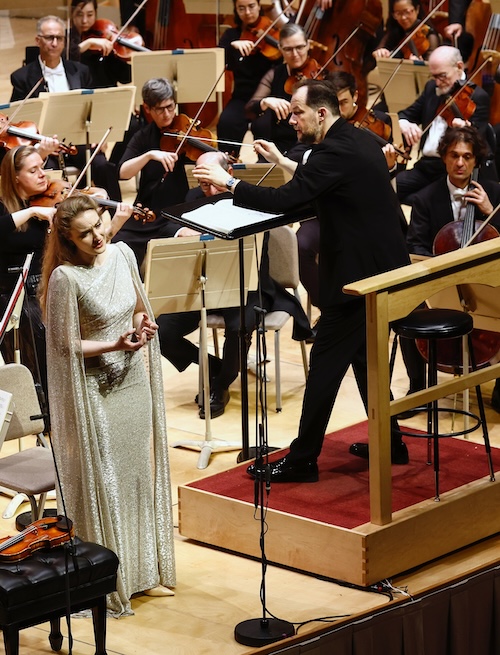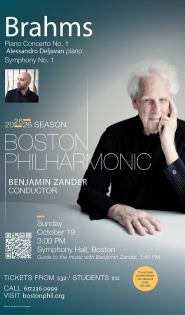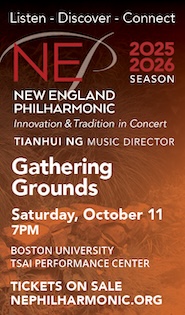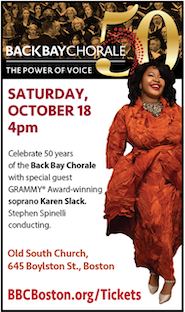Mixed Mahler and otherworldly Debussy from Nelsons, Boston Symphony

Soprano Nikola Hillebrand was the soloist in Mahler’s Symphony No. 4 with Andris Nelsons and the Boston Symphony Orchestra Thursday night. Photo: Winslow Townson
“I have thought for a long time of giving up these nonsensical terms allegro, andante, adagio, presto,” Beethoven wrote in 1817. “And Malzel’s metronome gives us the best opportunity to do so.” Not every composer, however, has shared Beethoven’s enthusiasm for the contraption. Claude Debussy, for one, found it tyrannical. So did Gustav Mahler.
As it happened, both composers shared the bill on the Boston Symphony Orchestra’s concert Thursday night at Symphony Hall, where the risks and rewards of their respective points of view were on full display.
It’s hard to imagine music less given to rigid beats-per-minute schemes than Debussy’s Nocturnes. Rather, this 25-minute-long gem thrives on flexible plays of color and subtle, in-the-moment manipulations of phrasing.
Thursday’s account, led by BSO music director Andris Nelsons, needed no assistance navigating those traits. This was a characterful, well-directed rendition that was, for the most part, beautifully blended and unfailingly transparent. True, the boisterous, central “Fêtes” was a shade texturally undefined. But its quiet spots were on-point and the music’s spatial aspect came across strongly.
In the outer movements, Nelsons and the BSO offered playing that elevated tone color to the level of tempo, harmony, texture, and rhythm. “Nuages” was a study in atmosphere and nuance, its shifting instrumental combinations and billowy gestures—not to mention Robert Sheena’s exquisite English horn solos—models of refinement.
The aptly named Lorelei Ensemble brought shapeliness and warmth to the vocal element in the concluding “Sirènes.” As in Nocturnes’ earlier sections, tempos and the blend of instruments here were near-ideal, Nelsons taking care to cushion the voices just above the orchestral fabric, like they were floating on the first movement’s clouds. The results were hypnotic and otherworldly.
More good singing, this time from soprano Nikola Hillebrand, marked the night’s take on Mahler’s Symphony No. 4. At the same time, that work’s purely instrumental movements were somewhat less persuasive.
Like Beethoven, Mahler was eager to do away with the aforementioned “nonsensical terms,” only he tended to replace them with vernacular ones of his own invention. Perhaps he would have been better served with a metronome marking or two, just at the beginning of things: in Mahler interpretation, much rests on getting that opening tempo right.
On Thursday, however, Nelsons and the BSO didn’t quite accomplish the last. Though the first movement clearly instructs “Nicht eilen”—don’t hurry—conductor and orchestra did just that, in the process exploding any possibility that this most delicate and intimate of Mahler symphonies would approach the subtlety and acuity of the chamber music it aspires to be.
Instead, the night’s take on the symphony’s first two sections veered towards roughness and bluster, in the process exposing some spotty ensemble. Dynamics, too, rarely came down as much as they needed to and balances were often problematic. As a result, concertmaster Nathan Cole’s sneering scordatura solos in the second movement didn’t consistently project above the larger ensemble.
Better results obtained over the symphony’s latter half. Though the Poco adagio felt micromanaged and its slow variations tended to drag, the lively ones were shapely and the BSO strings’ command of the Mahler idiom, with its gently scooping portamenti and shades of chiaroscuro, recalled the quality of the ensemble’s earlier foray into Debussy.
But it was Hillebrand’s arrival that really elevated Thursday night’s performance. Making her BSO debut, the German soprano offered an account of the finale’s “Das himmlische Leben” that was impeccably angelic: pure-toned, note-perfect, precisely enunciated, and unaffectedly expressive. Rarely does the song’s concluding lyric about heavenly voices awakening our spirits with gladness and joy come across so vividly (and without the benefit of the hall’s supertitles, which were obscured by the stage lighting).
Nelsons and the BSO seemed inspired by some combination of this vision and Hillebrand’s singing, delivering an accompaniment that was about as natural and discreet as Mahler’s written indications suggest it should be.
The program will be repeated 1:30 p.m. Friday and 8 p.m. Saturday at Symphony Hall. bso.org
Posted in Performances



